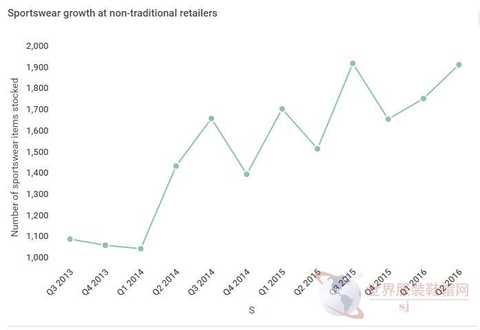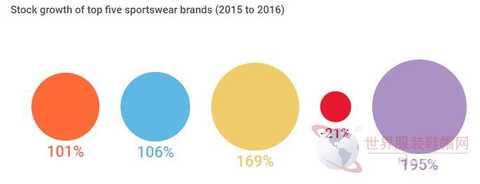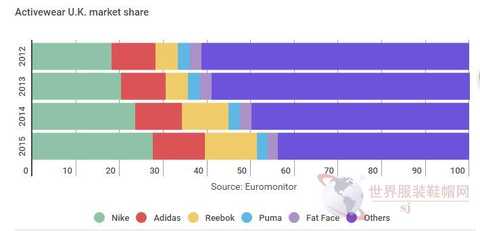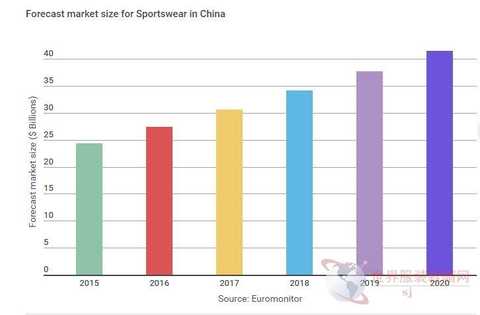In the field of sportswear, sports and leisure have not slowed down. People wearing sportswear outside the gym have become commonplace. The sports market is still far from saturation. The global market capacity in the sports and leisure sector will reach $270 billion. According to the data, there is still room for growth in the sports and leisure sector. Retail sales in the past six years have increased by 4.1%, while non-sportswear brands have increased by only 0.2%. People wearing sportswear outside the gym have become commonplace. Some critics say that this trend is about to become obsolete, but more retailers are keeping up with sports and leisure. "The sports market is still far from saturation. In fact, its ideal positioning is to completely change the way consumers live," said Katie Smith, senior retail analyst at Edited Data Platform. Recently, Edited analyzed data from 2,600 sportswear retailers in the UK and the US. The results showed that they not only increased their sales by 22%, but also increased their sales by 27%. In addition, the sports and leisure sector also presents the following trends. 1. Non-traditional retailers are breaking in Some "barbarians" outside the industry also smell the market's urgent need for fitness and casual wear. Brands that did not do sportswear in the past also tried to share a piece of cake. For example, Beyonce's black and white style, Ivy Park, launched in collaboration with Topshop is the best example of non-traditional retailers entering the sports and leisure sector. Once the brand was launched, it was sought after by fans. Growth trend of sportswear business of non-traditional retailers Compared with a luxury brand with thousands of leggings, high-quality and low-cost sports and leisure apparel are being mass-produced and increasingly appealing to consumers. There is a view that this in turn promotes the price decline. “Non-traditional retailers are just beginning to seize this huge opportunity for growth,†Smith said. “In order to maximize profits, retailers must not only keep up with the trend of the sport, but also make technological innovations on fabrics.†2. Large sports brands are still strong Although Ivy Park is the eighth online stock with the largest inventory, traditional sports trademarks still dominate this increasingly saturated market. According to the data of the Edited platform for nearly three months, the five most popular brands on the line are still Nike, Andema, Adidas sports performance series, Arthurs and Adidas. The table below shows the upward trend in the popularity of these five brands since the same period last year. It should be noted that the decline in the Adidas sports performance series is partly due to the main brand of Adidas. Five sportswear brand inventory data (2015-2016), from left to right, An Dema, Nike, Adidas, Adidas sports performance series, yaseshi “Consumers need high-tech, high-performance and ultra-high-performance clothing,†Smith said. In fact, according to data from market research firm Euromonitor, the leader in sports and leisure has not changed since 2012. As the leader of sports and leisure, Nike's market share is also increasing, while other major brands are also constantly taking the lead. Market share of sportswear brands in the UK 3. The second battlefield of sports and leisure apparel Instagram Fashion brands have always regarded Instagram as the second battlefield, as well as sports and leisure. The proportion of sportswear brands interacting on different social media platforms (British and American markets) Retail analysis company L2 collected data from January to April this year. The results show that most of the interaction between brands and consumers occurs on Instagram: among them, the proportion in the UK market is 93%, the US market is 94%. The proportion of interactions on Facebook is small, and the proportion of Twitter interactions between the United Kingdom and the United States is only 1%. According to L2, sports and leisure brands are paying more attention to the Instagram platform than platforms such as YouTube, and hope to release more content on it. 4. The Chinese market is growing rapidly As the Western market became saturated, markets such as China began to show an increasingly strong trend. Because the taste of the middle class here is also shifting from luxury goods to life and leisure. Lulu Lemon, which currently relies on Alibaba to manage its inventory, said its Hong Kong store is expected to reach $8 million in sales this year. China sportswear market size forecast In 2015, the Chinese sportswear market rose to $26.3 billion. And, according to the data, this number is expected to grow at a double-digit annual rate, which is expected to reach $43.1 billion in 2020. In contrast, during the same period, the luxury goods market is expected to reach only 28.4 billion US dollars. How does the sports and leisure brand take root in China? In the previous article of the Sui and Tang Dynasties, "How does the foreign sportswear brand stand firm in China?", Matthew Crab, director of Asia Pacific market research at Mintel, also issued a warning, a brand international. The popularity does not guarantee that it will gain a foothold in the Chinese market. “Foreign brands cannot underestimate the influence of Chinese culture and the understanding of Chinese brands on local markets and consumers. Brands don’t think that the rapid development of the Chinese market means the rapid expansion of the brand – before that, they have to face Many competitive pressures," Crab said. 5. Fashion designers teamed up with sports brands Sports and leisure winds not only scratched the streets, but also the fashion circle. Nowadays, it is not uncommon for fashion designers/entertainment stars to join hands with sports brands to launch sports and leisure production lines. For example, New York's famous designer Alexander Wang and the sportswear giant Adidas quietly collaborated to bring surprises to both the fashion industry and the sports world. The sports and leisure series launched by the two parties, with the inverted clover as the symbol, will once again push sports and leisure into the fashionable spotlight. Wang Daren According to the latest data from research firms Fung Global Retail & Technology and First Insight, consumers are willing to pay more for sports and leisure products than suggested retail prices. Moreover, the growth trend in the field of sports and leisure will be more normal, and the style of women's clothing will become more and more casual. The report covers 11 countries including the United States, Spain, and Canada. The report shows that consumers are willing to spend more on knit bottoming and leggings, up to 80% and 74% of the asking price. Jennifer Bandler, owner of sports fashion brand BANDIER, said that the meaning of sports and leisure has changed dramatically in the past few years. “When we first started BANDIER in 2014, there were also many sports brands,†she said. “Consumers are excited to see new brands and want to wear sportswear that expresses their individuality.†Before the popularity of sports and leisure, our sportswear has few choices and it is difficult to express our personal style. Nowadays, people can wear their own sportswear in different styles to show their individuality. Women Cotton Pajamas Sets,Cotton Pyjamas,Women Short Sleeve Sleepwear,Women Summer 2 Piece Set Pajamas GUANGZHOU CHEER INDUSTRY CO LTD , https://www.fashionwholesale2.com





Briefly describe the five major trends in the field of sports and leisure